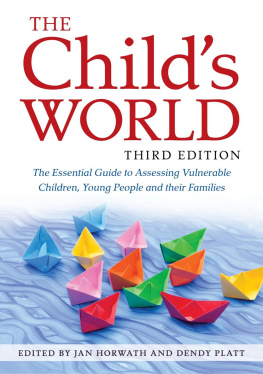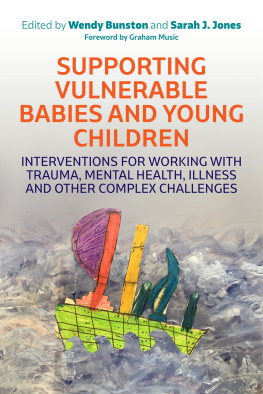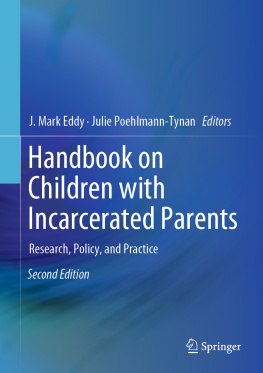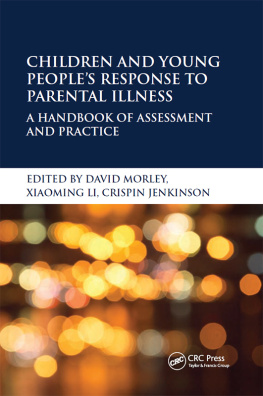Introduction
Jan Horwath and Dendy Platt
Background
This is the third edition of The Childs World. It is a completely rewritten and expanded edition, yet remains committed to the core assessment principles set out in previous versions. The core principles are that:
practitioners should recognise the lived experience of children and view assessment as part of an ongoing, dynamic process that leads to positive child-centred outcomes reflected in quality changes to their daily lives
effective assessment requires an ecological approach and a recognition of the contribution that practitioners from different disciplines make in understanding the world of the child and their family
engaging children and families in the assessment process is the first step to establishing a meaningful working relationship with them that is most likely to lead to change
it is important to build on strengths whilst recognising difficulties and understanding that each family is different
practice should be grounded in evidence-based research and practice knowledge that should be used to inform professional judgement.
We are aware that the working context has changed significantly over the last 20 years since the first edition of this book was produced (see this edition. They include child sexual exploitation, trafficking and online abuse and are topics only recently subject to research, policy and practice developments.
Our approach
Given the expanded nature of the book, two editors became necessary for this edition, and Dendy Platt joined Jan Horwath, who was the sole editor of the two previous editions. As editors we are keen that this resource book is user friendly. We want it to support assessments that are not overly ambitious, bearing in mind the resource constraints on workers, but lead to positive outcomes for children and young people. To ensure that we achieve these aims we consulted with practitioners, managers and students from a range of disciplines. Drawing on their views we seek to achieve the following:
Provide a guide to assessment for anyone in contact with children and families who, because of their role, may be involved in or lead an early help, child in need or child protection assessment. In using these terms, we acknowledge that different terminology is used to describe assessments across the range of organisations. The key point for us, however, is to make the content relevant to low-key assessments at a preventive level, as well as all the way through to complex assessments that contribute to court or childrens hearing processes where removal of children into the care system is under consideration.
Recognise the pressures on practitioners and managers dealing with complex and challenging situations routinely. The structure of the book is such that, apart from the three chapters on assessment task and process (), each chapter stands alone so that the reader can use the book as a go to resource for initial advice and suggestions on specific topics.
Draw on up-to-date policy, research and practice developments to provide practical but evidence-based advice as to how this knowledge should inform practice in the current working environment.
Ensure that specific guidance, tools, etc. are included with suggestions as to how they should be used as an aid to inform professional judgements. We do not want practitioners just to look for tools or questionnaires that simply offer a convenient assessment vehicle or a shortcut to careful, child-centred thinking. Rather, by reading about the various tools and assessment approaches in the context of a chapter as whole, practitioners can use them with appropriate analysis and professional judgement.
Recognise that effective assessment practice is underpinned by multidisciplinary working. We have attempted to pay attention to what practitioners from different disciplines can contribute to assessments as well as the part played by practitioners leading the assessment. We have tried to avoid the use of jargon and abbreviations in the text. Our view is that the use of such terms is not the basis of good practice; rather, it can be alienating to both families and practitioners from disciplines who are not familiar with the terms.
Address issues of diversity. This is arguably our greatest challenge. In preparing this book we have remained aware of the increasingly diverse groups within society, the ways in which some minority groups are marginalised and the hostility encountered by others. All chapters contribute in different ways to addressing these issues.
Offer practice examples. We have provided a case study that runs through ) and quotes from service users.
We not only consulted with practitioners regarding our approach, but we also had practitioners and students from different disciplines undertake peer reviews of the chapters, alongside academics involved in research and teaching. We hope that this process means that the book is relevant to current practice and the content is applicable to those completing assessments in a diverse range of child and family settings.
The political context
The first edition of The Childs World was produced in 2000 to support the implementation of the English and Welsh Framework for the Assessment of Children in Need and their Families (DH, DfEE and Home Office 2000). Since then there have been significant changes in the political context (see ). For example, since the 2010 edition was prepared, the devolved governments of Wales, Scotland and Northern Ireland have consolidated their positions and developed policies with more distinctive differences from those in England. Consequently, throughout this edition, we have identified policy and legislative requirements relevant to all four UK nations. Some chapters, however, may emphasise legislation in one or another of the four nations, depending on the expertise of the authors concerned.
Irrespective of the relevant nation, our approach to assessment in this book is driven by good practice rather than policy, and key messages (e.g. about the role of assessments or specific topics such as child sexual abuse or assessing parenting) are widely applicable irrespective of jurisdiction. There are many common policy themes in the assessment of children and families, both in the UK and in countries beyond our borders (subject, of course, to adjustments for cultural differences). These themes include the economic and social costs of populist and neo-liberal political ideologies, the effects of economic austerity on resource allocation, as well as specific approaches to children and families (e.g. for early help or removal of children into the care system).
Publication of the present edition coincides with a widespread return to populist, often neo-liberal, politics in several countries across the world. The ideology of neo-liberalism means an increase in free markets, growth in inequalities and privatisation and deregulation of public services, all of which are having a disproportionate impact on the poor. Populism accompanied by neoliberalism can lead to the apportioning of blame to vulnerable groups for the problems in society. These are the very groups with which this book is concerned.








